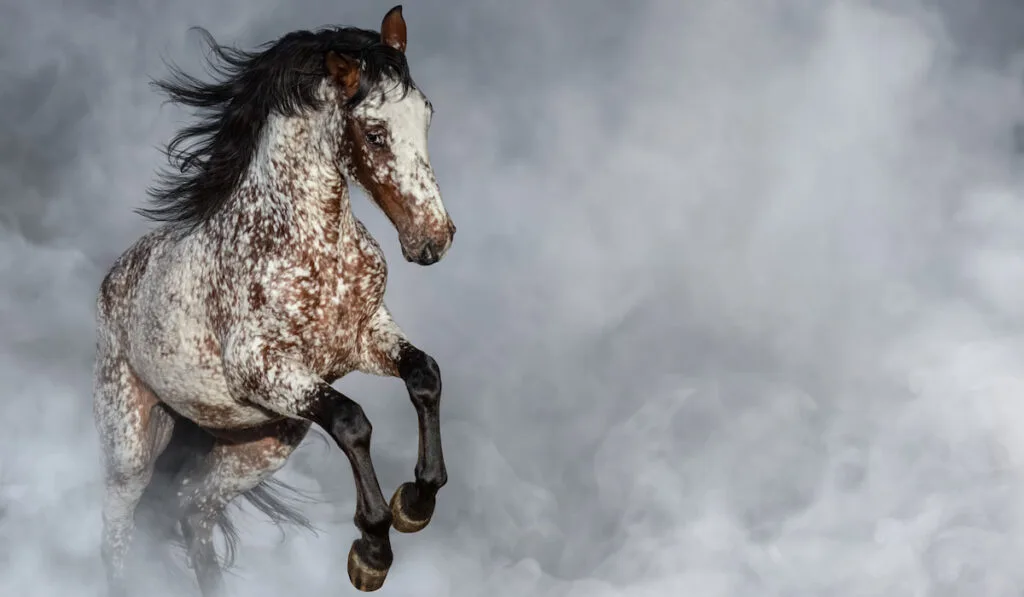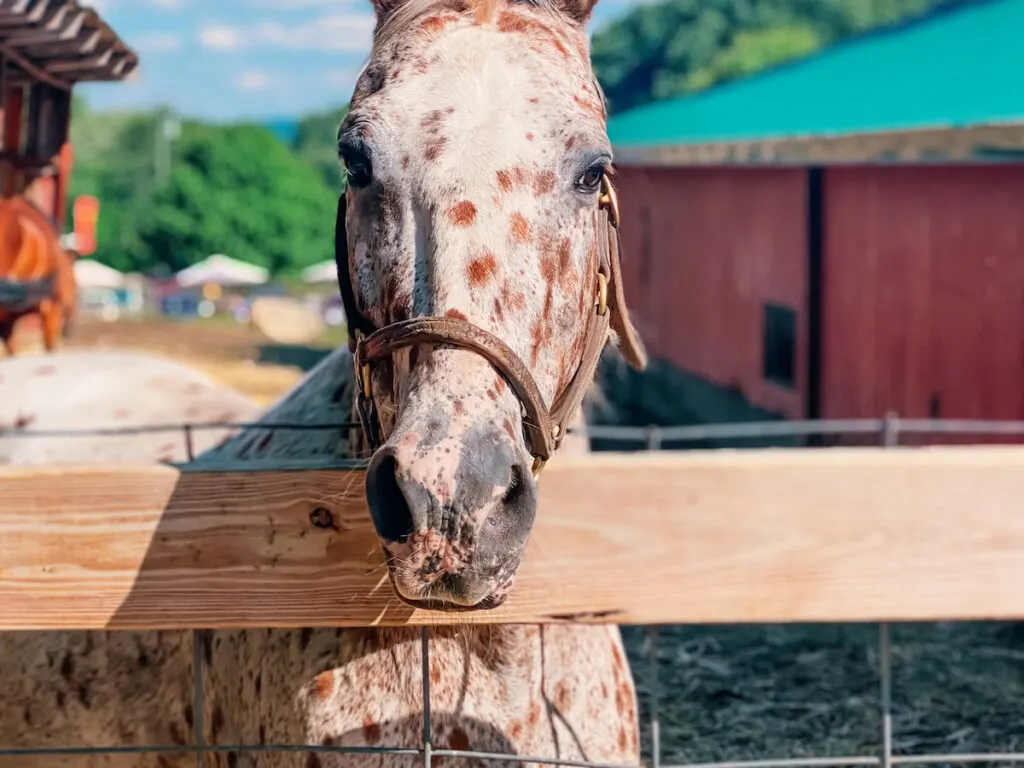Most equestrian enthusiasts are familiar with the splashy spotted coat of the Appaloosa. Or, maybe you’ve seen a miniature horse with some unique coloring. But did you know there are other horse breeds with distinctive spotting patterns? Here are some fun facts about 9 different horse breeds with spotted coats.
Table of Contents
Appaloosa

Height: 14.2 – 16.2 hands
Common disciplines: trail riding, ranch work, rodeos and performances, middle-distance racing, Western sports, jumping.
Not all spotted horses are Appaloosas, and not all Appaloosas have spots!
Appaloosas are hardy range horses developed in the US by the Nez Perce people in the 1700s. Strong, stocky, and agile, these spotted horses are suited for many disciplines.
While they don’t have specific conformation requirements like other breeds, registered Appaloosas must have Appaloosa characteristics.
Generally, they need to have one of 7 different spotted coat patterns (or other very specific eye and hoof characteristics in the case of solid-colored horses). The coat patterns of Appaloosa horses are like snowflakes – no two Appaloosas are exactly the same!
An Appaloosa’s spots are caused by a set of intricate genes called the leopard-complex. By selectively breeding generations of spotted horses with these genes, the Appaloosa’s coat became a primary characteristic of the breed.
Spotted horses were prized by the Nez Perce over solid-colored animals, and they have a legacy that continues to this day.
To learn more about this amazing spotted breed, check out my post with 19 Amazing Appaloosa Horse Facts.
Knabstrupper

Height: 15.2 – 16 hands (but may also be under 14.2 hands)
Common disciplines: dressage, show-jumping, general riding, carriage or performance horses
The Knabstrupper (or Knabstrup) exhibits the same coat color characteristics as the Appaloosa, although the breeds developed completely independently of each other. The Knabstrupper’s spotted coat is also caused by the leopard-complex.
While American Appaloosas are versatile stock horses, Knabstruppers more closely resemble warmblood sport horses. They are often used in dressage, jumping, or performances where their flashy coats stand out.
There are separate classifications for different types of Knabstruppers, including sport type, classic type, pony type, and miniature. This breed is relatively rare in the United States, but enthusiasts hope that one day this will change.
Miniature Horses

Height: 34” – 38” (measured at the last hairs of the mane, rather than the withers)
Common disciplines: companion animals, driving, equine agility, showing in-hand, service animals
Miniature horses were originally bred as companion animals for the British aristocracy. Once child labor was outlawed, they became exceptionally useful in the coal mines.
They are well-proportioned, and they more closely resemble horses, rather than ponies. Miniature horses may come in any color, including a sassy spotted coat.
The Falabella is a breed of miniature horse that was developed in Argentina. Crossing Spanish horses with small Thoroughbreds and Shetland ponies in a secluded region resulted in a small, refined miniature horse that was suitable for living in the harsh mountain climate.
These miniature horses were also often crossed with Appaloosas – a breed known for its hardiness, versatility, and good temperament (and quirky spotted coat!).
If you are wondering what the difference is between a horse, pony and mini horse, check out my article that answers that!
Pony of the Americas
Height: 11.2 – 14 hands
Common disciplines: Western stock events, endurance riding, three-day eventing, driving, jumping.
A relatively new breed, the Pony of the Americas began on a ranch in Iowa in the 1950s. The foundation sire for the breed was a Shetland-Arab-Appaloosa cross with a mark on his flank that looked exactly like a handprint.
These stock ponies are bred to be agreeable, easily trained, and may be outcrossed to many fine breeds – as long as he keeps his flashy spotted coat.

A registered Pony of the Americas must have spotted markings visible from a distance of forty feet. No boring brown coats for this breed! They are generally shown under saddle by children, or in-hand by adults.
Colorado Ranger
Height: 14.2 – 16 hands
Common disciplines: Western stock events, endurance, trail riding, English events, general riding
Colorado Rangers (also known as Colorado Rangerbreds) are versatile working horses that often have distinctive spotty coats.
In 1878, Ulysses S. Grant visited Sultan Abdul Hamid of Turkey. The Sultan presented Grant with two very fine stallions: an Arab named Leopard and a Barb named Linden Tree. Grant brought these stallions back to the United States, and they were bred to fine ranch horses.
All registered Colorado Rangers must trace their pedigrees back to foundation horses from Colby farm – the impressive horse breeding operation where the Colorado Ranger began.
Registered horses may be outcrossed with Appaloosas, and while flashy spotted coats are not required for registration, many Colorado Rangers have this trait.
British Spotted Pony

Height: 8 – 14.2 hands
Common disciplines: companion animal, general children’s riding horse, driving
This rare pony is native to England. They were popular because of their unique coat, and these ponies were often sent as gifts between members of royalty as carriage horses and mounts for children. There was originally a larger spotted horse, now that breed is considered a “British Appaloosa”.
While other pony breed registries permit flashy colored coats, the British spotted pony is known for its odd colorations. Pinto splashing colors are not allowed, but the traditional spotted coat patterns caused by the leopard-complex are encouraged.
Mustang

Height: May be any height, but most mustangs are small and generally reach between 14 and 16 hands.
Common Disciplines: Western stock events, Bureau of Land Management “Extreme Mustang Makeover” training challenge, trick riding, companion animals, general riding
Wild mustangs are as old as the American West itself. Prehistoric wild horses appeared in the Americas long before any human beings, but today’s wild mustangs are descendants of horses brought from Europe by Spanish conquistadors.
North America’s “wild mustangs” are domesticated feral horses, and many are caught, adopted, and tamed each year. As the indigenous people of the Americas adopted horses into their culture, they also began breeding them for color.
Plenty of spotted mustangs appeared in wild herds as these feral horses intermingled with their tame cousins on the open range. Today, mustangs come in nearly every color – a representation of their diverse genetic makeup.
Nez Perce Horse
Height: 15 – 16 hands
Common disciplines: Endurance, jumping, general riding
The Nez Perce people have been dedicated equestrians and skilled horse breeders since Spanish horses arrived in the Americas. More than one hundred years after their prized Appaloosas were disseminated and they were relocated to reservations, the Nez Perce created a new breed – the Nez Perce Horse (Or Nez Perce Appaloosa).
These long, lean, spotted endurance machines are the product of crossing registered purebred Appaloosas with sleek Akhal-Tekes, a rare Central Asian breed known for its unique metallic coat.
Many people believe that the new Nez Perce horses more closely resemble the rangey foundation Appaloosas of the past – slender, leggy, and speedy. Today’s Appaloosas tend to resemble the stocky quarter horse, a strong, athletic stock horse bred for life on a ranch.
Tiger Horse

Height: 13 – 16 hands, preferably 14-15.2
Common disciplines: general riding, ranch work, pleasure riding, trail riding.
Despite what the name implies, the Tiger Horse doesn’t have stripes – it has spots! One of the hardy breeds developed by the careful breeding efforts of the Nez Perce, the Tiger Horse is sweet, colorful, and gaited too! They can perform a comfortable four-beat gait colloquially called a “shuffle.”
In 1887, conflicts between the US government and the Nez Perce resulted in the loss of thousands of fine spotted horses. However, thanks to genetic testing and careful breeding, the Tiger horse is gaining in popularity because of it’s spotted coat color and comfortable shuffling gaits.
Final Thoughts
If you’ve always been attracted to the unique spotted coat colors of an Appaloosa, consider one of these other breeds as well! Maybe your next equine companion will sport a flashy dotted coat!









